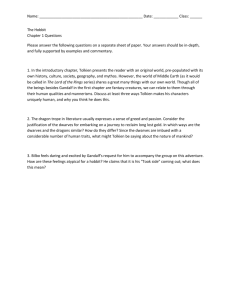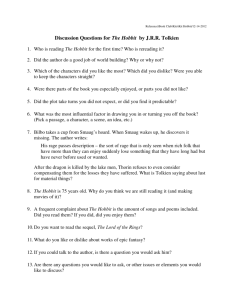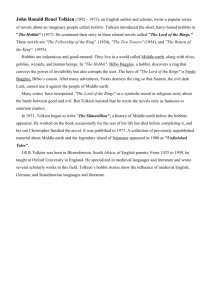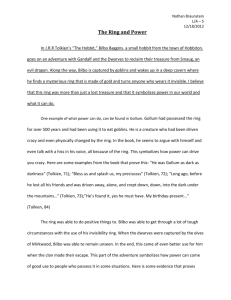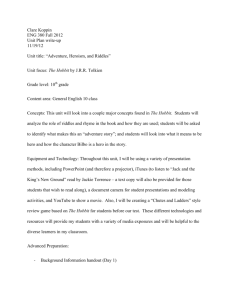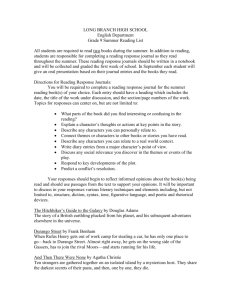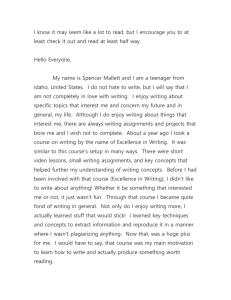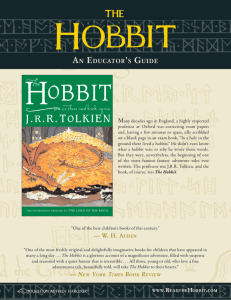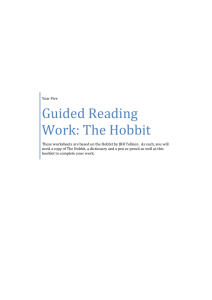The Hobbit Reader's Guide
advertisement
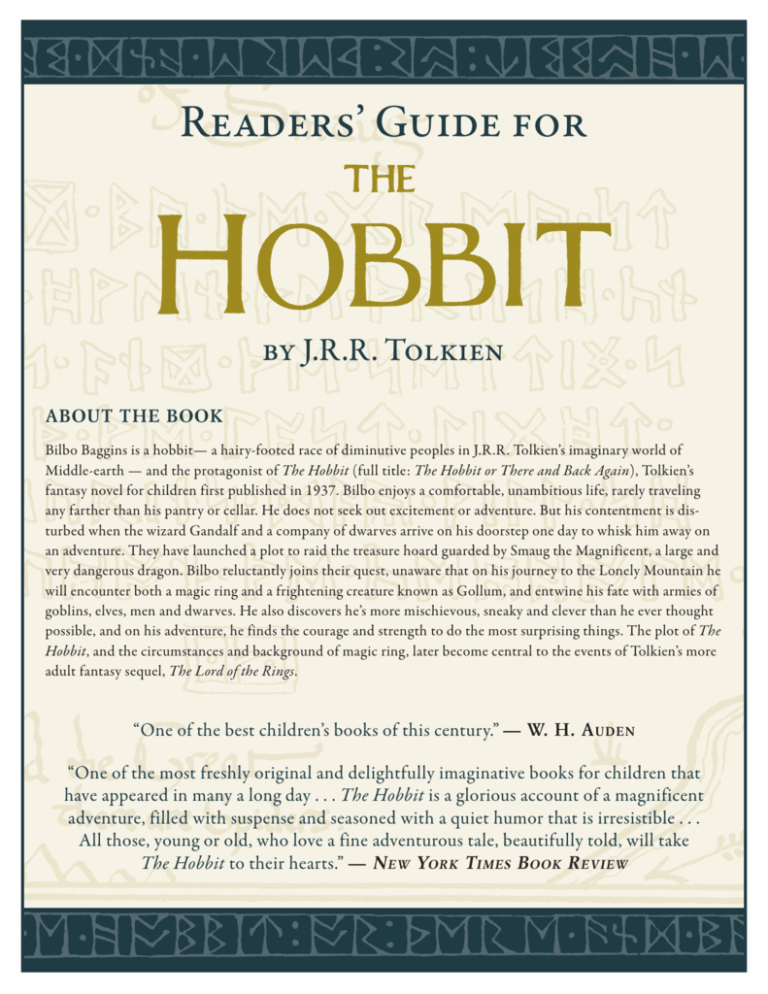
Readers’ Guide for by J.R.R. Tolkien ABOUT THE BOOK Bilbo Baggins is a hobbit— a hairy-footed race of diminutive peoples in J.R.R. Tolkien’s imaginary world of Middle-earth — and the protagonist of The Hobbit (full title: The Hobbit or There and Back Again), Tolkien’s fantasy novel for children first published in 1937. Bilbo enjoys a comfortable, unambitious life, rarely traveling any farther than his pantry or cellar. He does not seek out excitement or adventure. But his contentment is disturbed when the wizard Gandalf and a company of dwarves arrive on his doorstep one day to whisk him away on an adventure. They have launched a plot to raid the treasure hoard guarded by Smaug the Magnificent, a large and very dangerous dragon. Bilbo reluctantly joins their quest, unaware that on his journey to the Lonely Mountain he will encounter both a magic ring and a frightening creature known as Gollum, and entwine his fate with armies of goblins, elves, men and dwarves. He also discovers he’s more mischievous, sneaky and clever than he ever thought possible, and on his adventure, he finds the courage and strength to do the most surprising things. The plot of The Hobbit, and the circumstances and background of magic ring, later become central to the events of Tolkien’s more adult fantasy sequel, The Lord of the Rings. “One of the best children’s books of this century.” — W. H. A uden “One of the most freshly original and delightfully imaginative books for children that have appeared in many a long day . . . The Hobbit is a glorious account of a magnificent adventure, filled with suspense and seasoned with a quiet humor that is irresistible . . . All those, young or old, who love a fine adventurous tale, beautifully told, will take The Hobbit to their hearts.” — N ew York Times B ook R eview D iscussion Q uestions 1. Come up with a list of other adventure novels you’ve read and discuss where The Hobbit fits with those other titles. How does Bilbo undertake a classic hero’s journey and how does he differ from classical heroes? How does Tolkien both play into the genre and divert from it? 2. Although Tolkien creates a unique imaginary world, he also borrows extensively from the traditional elements of myths, fairy tales, fables, and folk tales. How do the elves, dwarves, trolls, talking animals, dragons, and other magical elements of The Hobbit compare to what you have seen in other literature you have read? 3. Why is it important that Gandalf is not present when the expedition meets the trolls in chapter two? 4. How are Bilbo and Gollum alike? What skills does Bilbo exhibit in how he deals with Gollum? 5. Discuss Beorn’s character. Who is he and what does he represent? Is he virtuous or vicious? 6. Why doesn’t Bilbo tell the dwarves about his ring? Do you consider this lying? 7. Why does Bilbo give up the Arkenstone? What does that gesture reveal about his character? 8. Does the story end the way you expected? How? Why? 9. What is the role of fate in The Hobbit? 10.In his book Secret Gardens: The Golden Age of Children’s Literature (Houghton Mifflin, 1985), Humphrey Carpenter calls The Hobbit “largely a sustained exploration of evil” (212). Explain why you agree or disagree with his description. 11.The past is very much present in The Hobbit: for Thorin, for the wood-elves, for the Master and the people of Esgaroth, for Bard, and even for Bilbo, who must reconcile the “Baggins” and “Took” sides of his personality. To what extent should we respect and learn from the past, and to what extent should we let it be past? 12.Consider the question of what is moral in the context of The Hobbit. The hero of the story is a burglar who conceals the truth from his friends, doesn’t quite “play fair” in a riddle contest, and steals the one part of the treasure that Thorin most desires. Do the ends always, or even often, justify the means? Is Bilbo consistently obeying a larger and greater good? 13.How does the phrase “More than meets the eye” summarize the experience of Bilbo Baggins and Bilbo’s experience of himself ? 14.Describe Bilbo’s own journey of self-discovery and transformation. How does he become more confident, more clever and more sure of himself ? How does he surprise himself ? How does he react to the personal changes he finds himself undergoing? 15.What role does luck play in the plot of The Hobbit? Are the characters in control of their own fates, or do they simply have good luck? 16.Describe the role of the Eagles. Does their sudden appearance at key points in the story relate to Tolkien’s ideas of luck and salvation? 17.How are the elves portrayed, particularly the wood-elves? Are they more or less frivolous than the elves of Rivendell? What does this suggest about Tolkien’s own view of the fairy world? 18.How would you describe the character of Smaug? Does he seem to know more than he lets on? How does Bilbo’s experiences with Gollum inform his later encounter with Smaug? 19.What is the nature of the dispute between the dwarves and the elves? How does it remind you of other disputes between other races, nations, and family members? 20.The full title of The Hobbit is The Hobbit or There and Back Again. In fact, the book ends with Bilbo beginning to write his memoirs, and in fact Tolkien purports to be merely the collector of Bilbo’s memoirs, on which he bases the book we are reading. How does this fictional frame shape how we read The Hobbit? Web S ites Houghton Mifflin Harcourt www.readthehobbit.com The Mythopoeic Society www.mythsoc.org The Tolkien Professor www.tolkienprofessor.com Tolkien Online www.tolkien-online.com Tolkien Society www.tolkiensociety.org Written by Edward T. Sullivan, a freelance writer and librarian, and revised by journalist and critic Ethan Gilsdorf, author of Fantasy Freaks and Gaming Geeks: An Epic Quest for Reality Among Role Players, Online Gamers, and Other Dwellers of Imaginary Realms © 2012 Houghton Mifflin Harcourt
